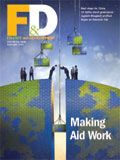 About F&D Subscribe Back Issues Write Us Copyright Information Burkina Faso and the IMF Free Email Notification Receive emails when we post new
items of interest to you. |
Burkina Faso: Greater Capacity Burkina Faso began a stabilization and structural adjustment program in 1991, with IMF and World Bank support. Since 1994, real GDP growth has averaged more than 5 percent a year, among the highest rates in sub-Saharan Africa. Economic recovery in the 1990s was the result of major economic and institutional reforms, including trade liberalization, especially for agricultural products; reform of the public enterprises sector, including banking; and fiscal reform that introduced a value-added tax and improved economic management. Debt relief, through the Heavily Indebted Poor Countries initiative, has helped ease an earlier debt overhang. But, the economy remains very vulnerable to external shocks, resulting in considerable fluctuations in growth. In 2004, growth fell to 4.6 percent from 8.0 percent in 2003, with the economy hampered by the oil price hike, the euro’s appreciation falling world prices for cotton (the main export), an invasion of locusts, and drought. Around 80 percent of the population remains dependent on agriculture, which is affected by poor rainfall and desertification, and just under half the population remains below the official poverty line. Over the past decade, the government has substantially increased budget allocations for social services resulting in key education and health indicators improving. But Burkina Faso has a long way to go to reach the MDGs and cannot do so without external aid. In order to implement our poverty reduction strategy and to boost spending further on infrastructure and the social sectors (including health, education, and water supplies), we will rely on a significant increase in external aid flows over the medium-term. The main framework for donor support is our Poverty Reduction Strategy Paper (PRSP), which was finalized in June 2000. A revised PRSP was adopted by the Council of Ministers on October 27, 2004, along with a priority action plan. Diversifying the economy Our medium-term growth strategy aims to diversify the economy and increase productivity while maintaining a stable macroeconomic environment. This will be done by focusing on rural development, agricultural diversification, and increased agricultural productivity, supported by the reform of public utilities and improvements in governance, with the aim of strengthening the business climate and promoting the development of the agricultural processing industry. The main difficulty still facing Burkina Faso is the persistently low absorption capacity for externally financed projects, with only about 70 percent of money committed by donors getting effectively disbursed. Of course, the absorption problem is not simply a matter of government policy. Our partners need to do more to make their aid easier to mobilize by maximizing budgetary support, while at the same time ensuring that the disbursement criteria are more manageable for the government. There is scope for boosting budget support, which accounted for less than 40 percent of total external financing during 2000–03, compared with project aid that was above 60 percent of the total. We are taking measures to increase absorptive capacity to help ensure that the proposed scaling up of expenditures would be effective. In the past, project implementation has been slower than expected, partly because of insufficient local administrative capacity and partly because of the sometimes cumbersome administrative procedures of donors. Recently, procedures for the release of budget support have been harmonized among donors, easing our administrative burden. To meet the additional demand for goods and services, we are supporting a number of programs to help small- and medium-sized enterprises engaged in construction and other services. Donors are also supporting reforms in the area of public procurement. We recently saw a breakthrough in aid management with the January 2005 signing of the General Organizational Framework for Budgetary Support for PRSP Implementation, which involved nine technical and financial partners. Its overall aim is to assist by means of nontargeted budget support, which can be more effective and less costly to manage. This has made the government more accountable for how it uses resources. Since 2002, the government has been implementing a plan to strengthen budget management that aims to make lasting improvements in terms of transparency, reliability, and effectiveness. Future aid should mainly serve to finance the implementation of the PRSP’s priority action plan. As the government strives for fiscal transparency, our partners should support these efforts by introducing mechanisms suited to our national environment, ensuring both effectiveness and transparency, coupled with predictability and flexibility, so that the exogenous shocks that so often beset our country may be better taken into account. This more open kind of partnership also allows for real government ownership of its policies, which is essential for achieving sustainable development. |